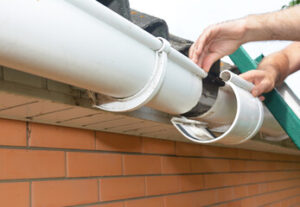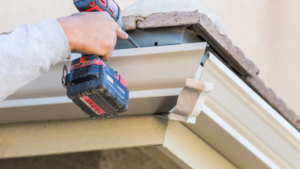Charleston Gutter Solutions might seem simple at first glance, but they play an important role in protecting your home from water damage. They effectively channel rainwater away from walls, foundations, and crawl spaces to prevent damage.

To keep your gutters in good working order, it’s essential to maintain them regularly. This can include flushing them with a garden hose to check for proper flow.
Gutter systems are responsible for the management of water around a home’s structure and foundation. They collect the rain that cascades off a roof and direct it away from the foundation of the house, preventing soil erosion and water damage to walls and windows. Gutter downspouts are also important for directing rainwater into drainage areas, which prevents the accumulation of moisture that can cause wood rot and other structural issues.
However, without proper maintenance, gutters can clog and overflow, leading to a variety of problems, from mildew growth to foundational cracks and flooding. Blocked gutters are especially dangerous, as they can lead to foundation problems and even leak into the basement. This is why it’s crucial to maintain a consistent schedule of cleaning and inspection, particularly during heavy rainfall.
Modern sustainable gutters are made from a range of eco-friendly materials, such as recycled aluminum and composite plastic, which reduce environmental impact while providing durability. They also use hangers that are secured with ferrules, which ensure a tight fit and a solid connection. This makes the system more stable and durable, reducing the need for frequent repairs.
Gutters are responsible for directing rainwater from the rooftop to the collection system, which is usually a storage tank or cistern. This water can then be used for irrigation or non-potable purposes, reducing the dependence on municipal water sources. These systems can also be coupled with permeable surfaces, which allow the rainwater to seep into the ground, preventing flooding and promoting groundwater recharge.
Gutter protection systems are an essential part of any green home remodeling project. These are available in a wide array of options, including surface tension guards and fine mesh guards, which prevent clogs and support water management. Additionally, they can be installed with first-flush diverters to eliminate the need for water collection and aeration. These features are an excellent way to promote a sustainable lifestyle and support the local ecosystem.
They prevent water damage
A gutter is a pipe or trough along the edge of a roof that carries rainwater away from a house. It also acts as a storm drain. Gutters are essential to a home, because they channel water away from the foundation, preventing soil erosion and basement flooding. They can also help prevent mold and mildew growth on the siding of a house. Gutters also prevent the accumulation of water on the roof, reducing the risk of leaks and rot.
Gutter systems are essential to your home’s safety and security. They channel water and snow away from the foundation of your home, preventing soil erosion and preserving the integrity of your house’s structure. They can also prevent standing water, which is an excellent breeding ground for mosquitoes and other harmful insects. Gutters are also essential for protecting the landscape of your home by routing water away from walkways and landscaping.
Proper gutter maintenance can prevent costly home repairs and damage. In addition, a well-functioning gutter system can increase your home’s value and curb appeal. However, the quality and slope of a gutter is crucial to its effectiveness. If a gutter has an inadequate slope, it may collect debris, overflow, or even collapse. This can cause a variety of issues, including rotting and mold, which can be harmful to your health.
If you want to avoid these problems, invest in high-quality gutters and downspouts. Make sure to choose durable materials, and always hire a professional for installation. In addition to high-quality gutters, it’s important to keep up with regular maintenance and cleaning. This will ensure that your gutters and downspouts are free from blockages and that water flows smoothly throughout your home.
Gutter maintenance can be a hassle, but it’s vital to protect your property from water damage. Insufficient care and maintenance can lead to roof leaks, basement flooding, foundation cracks, and soil erosion. It’s also important to keep up with seasonal maintenance. Changing weather conditions and debris can affect your gutters, making it necessary to clean them regularly. You should also inspect your gutters for holes and other damage before the rainy season.
They prevent pest infestations
Pest infestations are a nightmare for homeowners. They not only cause property damage, but they can also pose health threats. Infestations often begin with a single pest, such as a mosquito or rodent. However, they can quickly spread throughout a home. This can result in expensive repair costs, such as repairing chewed electrical wires and replacing damaged insulation. In addition, they can also weaken the structure of your roof and walls. To prevent pests from entering your home, you must keep it clean and free of debris. One way to do this is by regularly cleaning your gutters and using high-quality gutter protection.
A dirty gutter system can attract a wide variety of pests, including mosquitoes, ants, termites, centipedes, and mice. This is because a clogged gutter can harbor debris and standing water, which provides the ideal environment for pests to breed and grow. Additionally, a clogged gutter can lead to the growth of weeds and other unwanted plants.
Gutters can be a haven for pests because of their nutrient-rich, debris-filled environments. They are the perfect place for insects to thrive and build nests, which can block gutter downspouts and cause water damage to your house. In addition, pests can be a serious health hazard, as they can carry diseases like the Zika virus and West Nile virus.
The nutrient-rich, damp environment of a gutter can also be the perfect place for a bee hive to grow and thrive. While bees are a natural part of the ecosystem, they can become a nuisance when they begin to sting people or damage your property. To prevent bees from becoming a problem, you should trim the trees that overhang your house and clean your gutters regularly.
Clogged gutters can also create an environment that encourages the nesting of birds and rodents. These pests can cause major property damage, such as gnawing through wooden fascia boards and tearing off asphalt shingles. They can also contaminate your food and water supplies, leading to a range of health issues. A clogged gutter can be a breeding ground for mosquitoes, which can carry diseases such as Zika and dengue fever.
They prevent landscaping damage
Gutters prevent landscaping damage by directing rainwater to areas where it won’t affect your home and garden. In addition to preventing soil erosion, gutters can also keep your landscaping safe from unsightly water stains. Gutter systems also minimize moisture exposure and protect your walls from wood rot. Gutters are essential for protecting your home’s roof and foundation, but they can also help safeguard your yard, walkways, and trees. Besides preventing landscape damage, gutters can reduce pest infestation and enhance your home’s curb appeal. However, it’s important to maintain a properly functioning gutter system by ensuring that your gutters are clean and clog-free.
Without gutters, rainwater will flow down the sides of your house, which erodes the soil and washes away topsoil that is critical for plant growth. It can also wear away the surface of paved surfaces, such as driveways and sidewalks. Gutters prevent these damages by directing rainwater away from walkways, landscaping, and the foundation of your house.
A well-functioning gutter system also keeps your home’s siding and paint intact by diverting water away from the foundation. This can prevent water damage and prevent mold and mildew from forming, which is especially harmful to children and pets. In colder climates, gutters allow melting snow and ice to flow off the roof safely.
The best gutters are designed to be durable, with a solid structure and high-quality materials. They should have downspouts that are firmly attached to the house and a downspout extension that extends away from the building. They should also be installed in a level area, and the sloping of the house’s roof must be accounted for to ensure proper drainage.
A professional installer can recommend the right gutters for your home, and they will ensure that the gutter system is properly sized for your roof. A reputable company will install gutters that are long enough to handle large volumes of water, and they will make sure that the downspouts are correctly positioned and angled to avoid clogs. In addition, they will use gutter guards to prevent debris from getting into the system.
